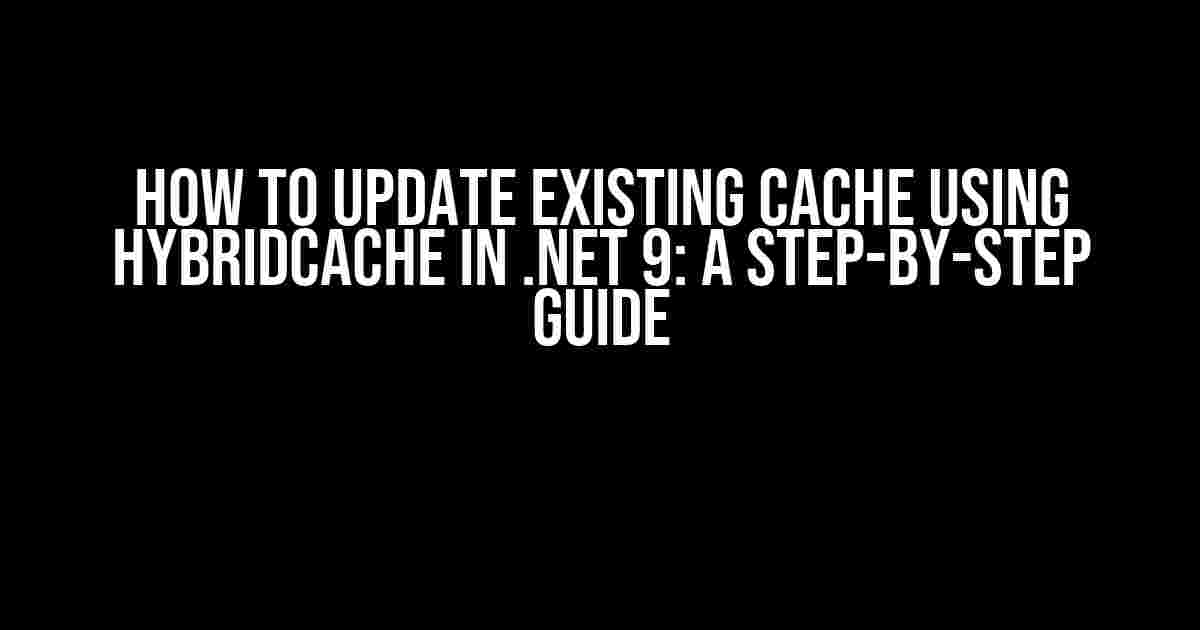Are you tired of dealing with outdated cache data in your .NET 9 application? Do you want to learn how to update existing cache using HybridCache? Look no further! In this comprehensive guide, we’ll walk you through the process of updating your cache using HybridCache in .NET 9.
What is HybridCache?
HybridCache is a caching mechanism in .NET 9 that allows you to store data in multiple caches, such as memory, disk, and distributed caches. It provides a flexible way to manage cache data and ensures that your application remains scalable and performant.
Why Update Existing Cache?
Updating existing cache is crucial to ensure that your application remains up-to-date and reflects the latest changes. Outdated cache data can lead to errors, inconsistencies, and poor performance. By updating your cache, you can:
- Ensure data consistency and accuracy
- Improve application performance and scalability
- Reduce errors and inconsistencies
- Enhance user experience
Updating Existing Cache using HybridCache
Now that you know why updating existing cache is important, let’s dive into the process of updating it using HybridCache in .NET 9. Follow these step-by-step instructions to update your cache:
Step 1: Configure HybridCache
Before you can update your cache, you need to configure HybridCache in your .NET 9 application. To do this, you’ll need to add the HybridCache NuGet package to your project:
dotnet add package Microsoft.Extensions.Caching.Hybrid
Once you’ve added the package, configure HybridCache in your Startup.cs file:
public void ConfigureServices(IServiceCollection services)
{
services.AddHybridCache(options =>
{
options.DefaultCacheDuration = TimeSpan.FromHours(1);
});
}
Step 2: Create a Cache Instance
Create a cache instance using the HybridCache provider:
private readonly IHybridCache _cache;
public CacheService(IHybridCache cache)
{
_cache = cache;
}
Step 3: Update Cache Data
Now that you have a cache instance, you can update the cache data using the SetCache method:
public async Task UpdateCacheDataAsync(string key, object data)
{
await _cache.SetCacheAsync(key, data, TimeSpan.FromHours(1));
}
In this example, we’re updating the cache data with a new value and setting the cache duration to 1 hour.
Step 4: Invalidate Cache Data
Sometimes, you may need to invalidate cache data to ensure that the cache remains up-to-date. You can invalidate cache data using the InvalidateCache method:
public async Task InvalidateCacheAsync(string key)
{
await _cache.InvalidateCacheAsync(key);
}
In this example, we’re invalidating the cache data with the specified key.
Tips and Best Practices
Here are some tips and best practices to keep in mind when updating existing cache using HybridCache in .NET 9:
- Use meaningful cache keys: Use descriptive and meaningful cache keys to ensure that you can easily identify and update cache data.
- Set cache durations wisely: Set cache durations based on your application’s requirements. Shorter durations may lead to more frequent cache updates, while longer durations may lead to outdated cache data.
- Use cache invalidation: Invalidate cache data when necessary to ensure that the cache remains up-to-date and reflects the latest changes.
- Monitor cache performance: Monitor cache performance and adjust your cache configuration as needed to ensure optimal performance and scalability.
Conclusion
Updating existing cache using HybridCache in .NET 9 is a straightforward process that requires careful planning and configuration. By following the steps outlined in this guide, you can ensure that your cache data remains up-to-date and reflects the latest changes. Remember to follow best practices and monitor cache performance to ensure optimal application performance and scalability.
| Cache Configuration | Default Cache Duration (Hours) |
|---|---|
| In-Memory Cache | 1 |
| Disk Cache | 2 |
| 4 |
In this article, we’ve covered the process of updating existing cache using HybridCache in .NET 9. By following these steps and best practices, you can ensure that your application remains scalable, performant, and up-to-date. Happy coding!
Frequently Asked Question
Get ready to rev up your .NET 9 development with HybridCache! If you’re struggling to update existing cache, we’ve got you covered. Here are the top 5 questions and answers to get you started.
How do I update an existing cache key using HybridCache in .NET 9?
To update an existing cache key, you can use the `HybridCache.Set()` method, passing in the updated value and the cache key. For example: `HybridCache.Set(“myCacheKey”, “newCacheValue”);`. Make sure you have the correct cache configuration and the key exists in the cache.
What’s the difference between `HybridCache.Set()` and `HybridCache.Add()` when updating existing cache?
`HybridCache.Set()` updates the value of an existing cache key, whereas `HybridCache.Add()` creates a new cache key if it doesn’t exist, or throws an exception if it already exists. If you’re unsure if the key exists, use `HybridCache.Set()` to ensure a smooth update process.
Can I update multiple cache keys at once using HybridCache in .NET 9?
Yes, you can update multiple cache keys at once by using the `HybridCache.SetAll()` method. This method takes a dictionary of key-value pairs, where the keys are the cache keys and the values are the updated values. For example: `HybridCache.SetAll(new Dictionary
How do I handle cache expiration when updating existing cache using HybridCache in .NET 9?
When updating existing cache, you can specify a cache expiration policy using the `CacheItemPolicy` class. For example: `var cacheItemPolicy = new CacheItemPolicy { AbsoluteExpirationRelativeToNow = TimeSpan.FromHours(1) }; HybridCache.Set(“myCacheKey”, “newCacheValue”, cacheItemPolicy);`. This sets the cache item to expire after 1 hour.
What are some best practices for updating existing cache using HybridCache in .NET 9?
Some best practices include using cache keys that are easy to understand and maintain, implementing cache expiration policies to ensure data freshness, and using the `HybridCache.Get()` method to retrieve cache values before updating to ensure consistency. Additionally, consider using asynchronous cache updates to improve performance.

